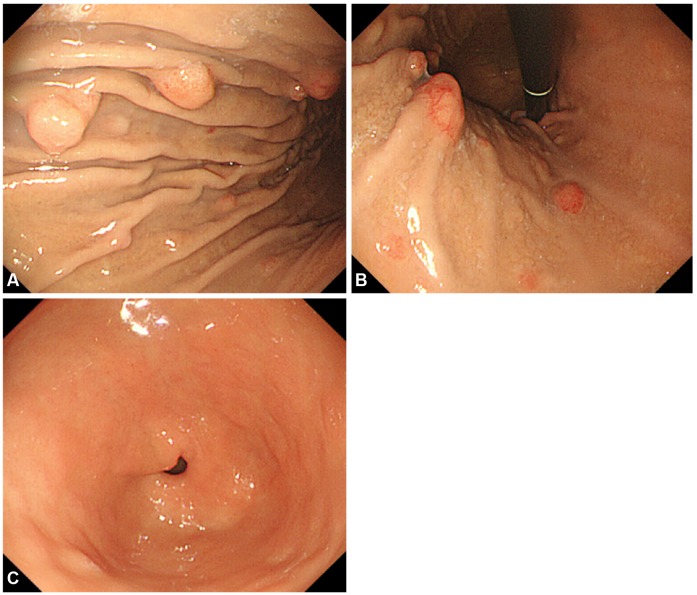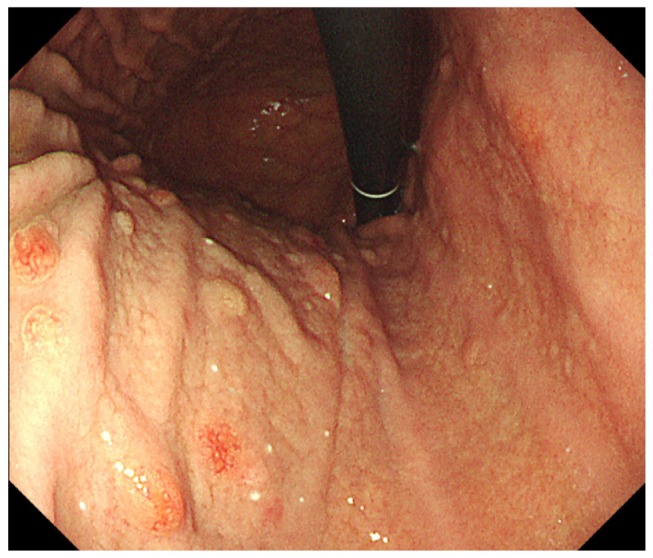Clin Endosc.
2015 Sep;48(5):431-435. 10.5946/ce.2015.48.5.431.
Multicentric Type 3 Gastric Neuroendocrine Tumors
- Affiliations
-
- 1Department of Internal Medicine, Yonsei University College of Medicine, Seoul, Korea. SKLEE@yuhs.ac
- 2Department of Pathology, Severance Hospital, Yonsei University College of Medicine, Seoul, Korea.
- 3Institute of Gastroenterology, Yonsei University College of Medicine, Seoul, Korea.
- KMID: 2148556
- DOI: http://doi.org/10.5946/ce.2015.48.5.431
Abstract
- A 50-year-old woman with incidentally detected multiple gastric polyps and biopsy-proven neuroendocrine tumor (NET) was referred to our hospital. More than 10 polypoid lesions (less than 15 mm) with normal gastric mucosa were detected from the gastric body to the fundus. The serum level of gastrin was within the normal limits. There was no evidence of atrophic changes on endoscopy and serologic marker as pepsinogen I/II ratio. Computed tomography of the abdomen and pelvis revealed no evidence of metastatic lesions. She refused surgery, and we performed endoscopic polypectomy for almost all the gastric polyps that were greater than 5 mm. Although the histological examination revealed that all the removed polys were diagnosed as NET G1, three of them extended to the lateral or vertical resection margins, while two exhibited lymphovascular invasion. A follow-up upper endoscopy that was performed 6 months after the diagnosis showed multiple remnant gastric polyps that were suggestive of remnant gastric NET.
Keyword
MeSH Terms
Figure
Reference
-
1. Modlin IM, Lye KD, Kidd M. A 5-decade analysis of 13,715 carcinoid tumors. Cancer. 2003; 97:934–959. PMID: 12569593.
Article2. Lawrence B, Gustafsson BI, Chan A, Svejda B, Kidd M, Modlin IM. The epidemiology of gastroenteropancreatic neuroendocrine tumors. Endocrinol Metab Clin North Am. 2011; 40:1–18. PMID: 21349409.
Article3. Modlin IM, Lye KD, Kidd M. A 50-year analysis of 562 gastric carcinoids: small tumor or larger problem? Am J Gastroenterol. 2004; 99:23–32. PMID: 14687136.
Article4. Rindi G, Luinetti O, Cornaggia M, Capella C, Solcia E. Three subtypes of gastric argyrophil carcinoid and the gastric neuroendocrine carcinoma: a clinicopathologic study. Gastroenterology. 1993; 104:994–1006. PMID: 7681798.
Article5. Bordi C. Gastric carcinoids. Ital J Gastroenterol Hepatol. 1999; 31(Suppl 2):S94–S97. PMID: 10604110.6. Hassan MM, Phan A, Li D, Dagohoy CG, Leary C, Yao JC. Risk factors associated with neuroendocrine tumors: a U.S.-based case-control study. Int J Cancer. 2008; 123:867–873. PMID: 18491401.
Article7. Delle Fave G, Capurso G, Annibale B, Panzuto F. Gastric neuroendocrine tumors. Neuroendocrinology. 2004; 80(Suppl 1):16–19. PMID: 15477710.
Article8. Fléjou JF. WHO Classification of digestive tumors: the fourth edition. Ann Pathol. 2011; 31:S27–S31. PMID: 22054452.9. Delle Fave G, Kwekkeboom DJ, Van Cutsem E, et al. ENETS Consensus Guidelines for the management of patients with gastroduodenal neoplasms. Neuroendocrinology. 2012; 95:74–87. PMID: 22262004.
Article10. Bordi C, D'Adda T, Azzoni C, Pilato FP, Caruana P. Hypergastrinemia and gastric enterochromaffin-like cells. Am J Surg Pathol. 1995; 19(Suppl 1):S8–S19. PMID: 7762739.11. Thomas D, Tsolakis AV, Grozinsky-Glasberg S, et al. Long-term follow-up of a large series of patients with type 1 gastric carcinoid tumors: data from a multicenter study. Eur J Endocrinol. 2013; 168:185–193. PMID: 23132699.
Article12. Merola E, Sbrozzi-Vanni A, Panzuto F, et al. Type I gastric carcinoids: a prospective study on endoscopic management and recurrence rate. Neuroendocrinology. 2012; 95:207–213. PMID: 21811050.
Article13. Spinelli P, Cerrai FG, Casella G, Pizzetti P. Endoscopic treatment of gastric carcinoids. Minerva Chir. 1994; 49:271–273. PMID: 8072701.14. Basuroy R, Srirajaskanthan R, Prachalias A, Quaglia A, Ramage JK. Review article: the investigation and management of gastric neuroendocrine tumours. Aliment Pharmacol Ther. 2014; 39:1071–1084. PMID: 24628514.
Article15. Kwon YH, Jeon SW, Kim GH, et al. Long-term follow up of endoscopic resection for type 3 gastric NET. World J Gastroenterol. 2013; 19:8703–8708. PMID: 24379589.
Article16. Bordi C, Falchetti A, Azzoni C, et al. Aggressive forms of gastric neuroendocrine tumors in multiple endocrine neoplasia type I. Am J Surg Pathol. 1997; 21:1075–1082. PMID: 9298884.
Article17. Hosoya Y, Fujii T, Nagai H, Shibusawa H, Tsukahara M, Kanazawa K. A case of multiple gastric carcinoids associated with multiple endocrine neoplasia type 1 without hypergastrinemia. Gastrointest Endosc. 1999; 50:692–695. PMID: 10536330.
Article18. Katsinelos P, Chatzimavroudis G, Kotakidou R, Zavos C, Paroutoglou G, Kountouras J. Diffuse gastric carcinoid polyposis in multiple endocrine neoplasia 1 syndrome without hypergastrinemia. Gastrointest Endosc. 2007; 66:411–412. PMID: 17524399.
Article
- Full Text Links
- Actions
-
Cited
- CITED
-
- Close
- Share
- Similar articles
-
- Diagnosis and Treatment of Gastric Neuroendocrine Tumors
- Endoscopic Treatment of Gastric and Duodenal Neuroendocrine Tumors: Present and Future
- Multiple Neuroendocrine Tumors in Stomach and Duodenum in a Multiple Endocrine Neoplasia Type 1 Patient
- Neuroendocrine Tumors of the Female Reproductive Tract: A Literature Review
- Primary Gastric Neuroendocrine Tumor with Hepatic Metastasis




